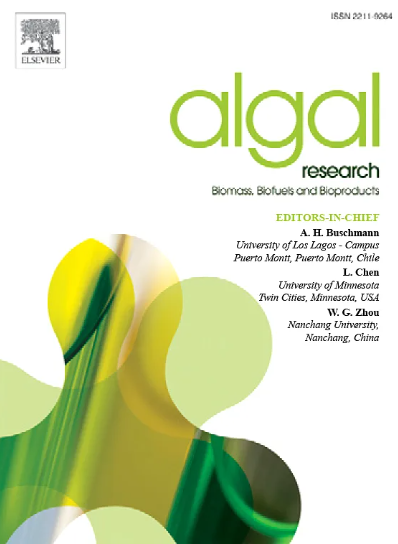通过比较转录组和生理分析揭示两种 DNA 甲基转移酶抑制剂对莱茵衣藻 DNA 甲基化和类胡萝卜素代谢的影响
IF 4.5
2区 生物学
Q1 BIOTECHNOLOGY & APPLIED MICROBIOLOGY
Algal Research-Biomass Biofuels and Bioproducts
Pub Date : 2024-10-11
DOI:10.1016/j.algal.2024.103739
引用次数: 0
摘要
DNA 甲基化在细胞生长和发育中发挥着重要作用。然而,人们对微藻类 DNA 甲基化的可能功能知之甚少。在此,研究人员用两种DNA甲基转移酶(DNMT)抑制剂(5-氮杂胞苷和斑蝥碱)处理莱茵衣藻,研究DNA甲基化对微藻的影响。5-氮杂胞苷(5-Azac)对细胞生长有促进作用,并有利于色素的积累,而斑马琳(Zeb)则对藻类细胞的生理有不利影响。然而,使用两种 DNMT 抑制剂处理的 C. reinhardtii 基因组却意外地显示 5-mC 含量略有增加。根据对使用 Zeb 和 5-Azac 处理过的藻细胞进行转录组测序的结果,发现两种 DNMT 抑制剂会上调参与胞嘧啶甲基化途径的基因的转录水平,下调参与胞嘧啶去甲基化途径的基因的转录水平,这可能会导致基因组中的 5-mC 水平升高。5-Azac 增加了类胡萝卜素的含量,这可能是由于上调了胡萝卜素生成基因的转录水平。此外,类胡萝卜素降解相关基因的转录水平上调可能是 Zeb 导致类胡萝卜素含量降低的原因。最后,从 C. reinhardtii 中分离出了类胡萝卜素 9,10(9′,10′)-裂解二氧酶 1(CrCCD1)基因,并证明了其在类胡萝卜素降解中的重要作用。综上所述,本研究揭示了在两种DNMT抑制剂作用下,C. reinhardtii的生理变化和分子机制,为后续微藻DNA甲基化的研究提供了有价值的信息。本文章由计算机程序翻译,如有差异,请以英文原文为准。
Revealing the effects of two DNA methyltransferase inhibitors on DNA methylation and carotenoid metabolism in Chlamydomonas reinhardtii by comparative transcriptome and physiological analysis
DNA methylation plays an important role in cell growth and development. However, little is known about the possible functions of DNA methylation in microalgae. Here, two DNA methyltransferase (DNMT) inhibitors (5-azacytidine and zebularine) were used to treat Chlamydomonas reinhardtii to investigate the effects of DNA methylation on microalgae. 5-Azacytidine (5-Azac) showed the promoting effects on cell growth and was benefit to the accumulation of pigments, while zebularine (Zeb) has adverse effects on the physiology of algal cells. However, the genomes of C. reinhardtii treated with two DNMT inhibitors unexpectedly showed slightly increased 5-mC levels. According to the results of transcriptome sequencing to algal cells treated with Zeb and 5-Azac, two DNMT inhibitors were found to up-regulate the transcription levels of genes involved in the cytosine methylation pathway and down-regulate genes involved in the cytosine demethylation pathway, which may result in higher 5-mC levels in genome. The increased content of carotenoids by 5-Azac may be due to the up-regulated transcription levels of carotenogenic genes. In addition, the up-regulated transcription levels of carotenoid degradation-related genes may be responsible for the reduced carotenoid content by Zeb. Finally, a carotenoid 9,10(9′,10′)-cleavage dioxygenase 1 (CrCCD1) gene was isolated from C. reinhardtii, and its important role in carotenoid degradation was demonstrated. In summary, this study revealed the physiological changes and molecular mechanisms of C. reinhardtii under the effects of two DNMT inhibitors, providing valuable information for subsequent studies on DNA methylation in microalgae.
求助全文
通过发布文献求助,成功后即可免费获取论文全文。
去求助
来源期刊

Algal Research-Biomass Biofuels and Bioproducts
BIOTECHNOLOGY & APPLIED MICROBIOLOGY-
CiteScore
9.40
自引率
7.80%
发文量
332
期刊介绍:
Algal Research is an international phycology journal covering all areas of emerging technologies in algae biology, biomass production, cultivation, harvesting, extraction, bioproducts, biorefinery, engineering, and econometrics. Algae is defined to include cyanobacteria, microalgae, and protists and symbionts of interest in biotechnology. The journal publishes original research and reviews for the following scope: algal biology, including but not exclusive to: phylogeny, biodiversity, molecular traits, metabolic regulation, and genetic engineering, algal cultivation, e.g. phototrophic systems, heterotrophic systems, and mixotrophic systems, algal harvesting and extraction systems, biotechnology to convert algal biomass and components into biofuels and bioproducts, e.g., nutraceuticals, pharmaceuticals, animal feed, plastics, etc. algal products and their economic assessment
 求助内容:
求助内容: 应助结果提醒方式:
应助结果提醒方式:


